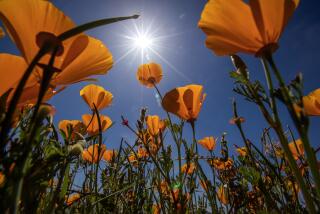Gardeners: It’s Time to Dig In. : Warm Soil, Good Weather Encourage Planting Now
- Share via
Strategically, fall is the best time to plant just about anything, because nearly everything works in the gardener’s favor. The soil is warm so roots immediately begin to grow into their new home; rain is on the way (the National Weather Service is predicting a wetter-than-usual autumn), so watering will be less of a chore, and some weeks watering won’t be necessary at all.
The weather is perfect for working outdoors. The crisp morning air is full of anticipation and spurs one on. The one fly in the soup is that devil wind called a Santa Ana. But even this hot, dry wind is less stressful on plants than most people suspect--certainly easier on new plants than week after week of consistently hot weather, which is what they’ll run up against if planted in the spring.
So what can you do on these delightful fall days? You can plant things like trees and shrubs that might be planted at any time of the year but are best planted now; those flowers and vegetables that flower or fruit or are ready for harvest in the spring, and, of course, those bulbs that flower in the spring.
Bulbs are the first to come to mind, because they are traditionally planted during the autumn months, but here in Southern California, we have our own little twists. We can plant many bulbs that are marginal or impossible in other parts of the country. They are listed in our planting chart and include all sorts of bulbs from climates similar to our own, from the tall watsonias to the dainty, fragrant freesias.
Another twist is when we plant some of the more traditional bulbs. Daffodils should go in as soon as possible, because they need to grow a sturdy root system before flowering. Plant them too late in the season and they will not flower.
But tulips and hyacinths are the opposite. They shouldn’t be planted until late November or even the end of January, a date so late it surprised even me, and I thought I had heard every little twist of California gardening by now. Charles Cozzens, who grows a magnificent garden in San Diego’s North County, never plants tulips before the end of January, because “plant them any earlier and you count on the flowers opening during one of those late winter, Santa Ana heat waves, so they last but a day or two. Plant in late January and they will flower during the late spring months, when cool, overcast days are likely.”
Helen and Jack Crawford of Covina traditionally put in 2,000 tulip bulbs the day after Thanksgiving. The neighborhood pitches in, because the large bed is in the front yard, and by April, it’s a mass of flowers that can be enjoyed by all. The show continues into May as different varieties come into flower.
What you should do now is buy the tulip bulbs, while they are in good supply, and then put them in the refrigerator (not the freezer). Tulips need this artificial chilling to flower well, and Cozzens has a few extra old refrigerators in the garage just for that purpose.
Some of the prettiest and easiest flowers bloom in the spring, and these too must be planted now, the sooner the better. Again, check our planting table to see the possibilities. The first to go in the ground should be those annuals that flower in the spring, such as calendulas, Iceland poppies, stock and sweet peas.
For a more casual look, mix perennial flowers in with the annuals, such as delphiniums, salvia, Shasta daisies and Veronica. The perennials will help extend the show, because they tend to bloom in May and June, while the annuals flower most in April. The perennials bring a casual air to a garden, because they are not so uniform or predictable as annuals.
For an even more casual look, consider planting those spring-blooming flowers that are native here, or from climates so much like our own that they will grow just like our native wildflowers, sprouting with the first rain, blooming in the spring and then turning dry and golden for the summer.
Scriptwriter Sujenna Anderson calls herself a “haphazard gardener,” yet her garden in Arcadia is as pretty as a wildflower field.
“I always plant everything too close together, am terrible at remembering to fertilize, don’t do much to the soil and only weed, frankly, when I feel like it,” she says. Her garden grows nonetheless and flowers with great profusion in the spring.
Her secret? She grows those annuals that act like wildflowers, or actually are. Great drifts of pink and lavender clarkia, golden California poppies, pink Mexican primrose and shocking red field poppies surround stands of Wedgwood blue-bearded iris and spiky yuccas. Weedy grasses also grow with the flowers, and though she pulls some when they are small, most are only removed just before they go to seed, which seems to provide just enough control so they don’t overwhelm the flowers; instead, they make a delicate foil.
This is also a twist of climate, because while most flowers sprout and grow during the spring in other parts of the country, here they do so in the fall, as the rains arrive.
There are also a number of vegetables that grow only during the cooler months, and they may be planted now through March. Included in this group of cool-weather crops are carrots, lettuce, the cole crops and the several others in our fall-planting list.
Yet other autumn opportunities are those plants that will become a permanent part of the garden, from ground covers to trees. Here the reasoning is a little different. While the flowers and bulbs that bloom in the spring must be planted now, these permanent residents of the garden can be planted at just about anytime in the year, though they will get off to a surer start now.
Planted anytime before the middle of November, these plants will make immediate growth below ground, though you will see precious little happening above ground. Because the soil is still warm from summer, the roots quickly grow out of their root ball and into the surrounding soil. By spring, they are well established and are ready for a burst of growth.
Fall-planted trees and shrubs seem to almost explode in March and April as new growth bursts forth. And remember, you won’t have to water them nearly as often and there will be weeks when you can simply turn your back on them.
Many of these permanent plantings will need little water next summer because their roots will have grown deep enough to tap moisture conserved well below ground. Compare this to planting in the spring, when a whole summer of constant watering is just ahead.
There are advantages to planting in the fall.






